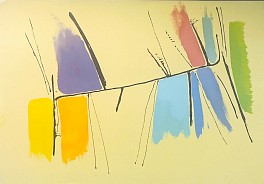BIOGRAPHY

American (1942-2007)
Among America’s leading abstract artists, Dan Christensen (1942-2007) was devoted over the course of forty years to exploring the limits, range, and possibilities of paint and pictorial form. Although his art belongs within the category defined by the influential art critic Clement Greenberg as Color Field or Post-Painterly Abstraction, he both carried on the legacy of this approach while stepping outside of it, through drawing from a wide variety of Modernist sources, using many idiosyncratic techniques, and employing methods more commonly associated with the action painting techniques of Abstract Expressionism. The result is a distinctive body of artwork that is original, surprising, and filled with joy, exuberance, and pleasure in the act of painting.
The critic Clement Greenberg anointed him in 1990 as “one of the painters on whom the course of American art depends.” Greenberg viewed Christensen as an exemplar of “post-painterly abstraction”—a term he coined for the movement that followed Abstract Expressionism in modernist progress towards what Greenberg regarded as a “pure art” that would eschew subject matter, spatial illusion and an artist’s persona in favor of revealing the “truthfulness” of the canvas. His paintings employed a variety of tools, including spray guns, trowels and squeegies. The constant in his art was the importance of color and his work shows a continual exploration of the possibilities of color.
Born in Cozad, Nebraska, in 1942, the son of a farmer and truck driver, Dan Christensen chose to become an artist when, as a teenager, he saw the work of Jackson Pollock on a trip to Denver. After receiving his B.F.A. from the Kansas City Art Institute, Missouri, in 1964, he moved to New York City. His “spray loop” paintings, produced by using a spray paint gun, were a fascinating embodiment of the reductive abstract tendencies in 1960s American art, and of the interest of the time in innovative applications of new techniques. With their powerful ribbon-like configurations, and shimmering allover surface effects, these works won the attention of Greenberg, who became an enthusiastic supporter of Christensen’s art.
Dan Christensen had his first solo exhibition in New York in 1967. Two years later he was given his first one-person show at the Andre Emmerich Gallery, joining this important showcase for color-field painting, where works by artists such as Kenneth Noland, Jules Olitski, and Helen Frankenthaler were also shown. Christensen soon started to be invited to participate in major museum shows, including the Whitney Annuals in New York and the Corcoran Gallery’s Biennials, in Washington, D.C. From the 1970s until his death in 2007, Dan Christensen was unrelenting in his exploration of new techniques as well as in his return in new ways to treat forms that had held his attention in the past.
Christensen’s paintings can be found in the collections of the Guggenheim, the Whitney Museum of American Art, the Metropolitan Museum of Art and the Museum of Modern Art in New York; the Albright-Knox Gallery; the Hirshhorn Museum of the Smithsonian Institution; the Butler Institute of American Art; the Chicago Art Institute; the Houston Museum of Fine Arts; the Seattle Art Museum; and the Fine Arts Museum of San Francisco, among many others.
